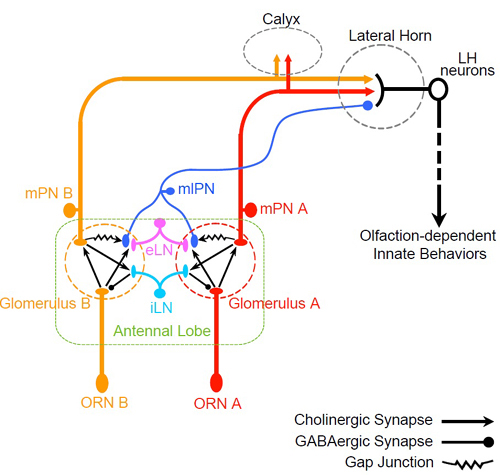Time:2014-02-11
Animals utilize their sensory systems to detect the external physical and chemical signals in order to adapt themselves to the environment. Olfaction is one of the most important sensory modalities for animals to identify food, mating partners and avoid predators. Olfactory signals comprise of thousands of volatile molecules. How the brain codes and processes such a huge amount of olfactory information is a key question in neuroscience. The olfactory system of the fruit fly-Drosophila melanogaster provides an ideal model system to address this scientific question, because of its simplicity and its analog to the mammalian olfactory system.
In Drosophila, the chemical cues in the environment are detected by the olfactory receptor neuron (ORNs) resided in the external olfactory organs, the antennae and the maxillary palps. Then, the olfactory information received by ORNs is conveyed to the antennal lobes (ALs), processed by local circuits, and further relayed to higher brain regions via multiple pathways. The excitatory pathway, which is well studied, is mediated by the cholinergic projection neurons (mPNs). In contrast, the function and connectivity of the inhibitory pathway mediated by GABAergic projection neurons (mlPNs) remains largely unknown.
To study how these pathways coordinately process olfactory information, Dr. WANG Kaiyu from Dr. WANG Zuoren’s lab, working together with other collaborators, systematically investigated the connectivity, odor responses, and behavioral significance of mlPNs. They found that mlPNs receive inputs from both ORNs and mPNs, and provide lateral outputs to other neurons in the AL via gap junctions. The axons of mlPNs target the downstream neurons of mPNs in the LH, and the inhibiton provided by the mlPN pathway modulate the expression of olfaction-dependent innate behaviors.
Their study demonstrates that the two pathways formed by GABAergic PNs and cholinergic PNs, respectively, shared the same primary input, interacted with each other via cholinergic and electrical synapses, and carried olfactory information coordinately in opposite polarities. This organization is important for Drosophila to process olfactory information and behave properly.
This research entitled “Parallel pathways convey olfactory information with opposite polarities in Drosophila” was published online in PNAS USA on February 10, 2014. The work was supported by Strategic Priority Research Program of Chinese Academy of Sciences and the 973 Project of the Ministry of Science and Technology.

A model depicting how excitatory (cholinergic mPNs) and inhibitory (GABAergic mlPNs) pathways coordinately process olfactory information and inhibit abnormal olfactory behavior.
 附件下载:
附件下载: